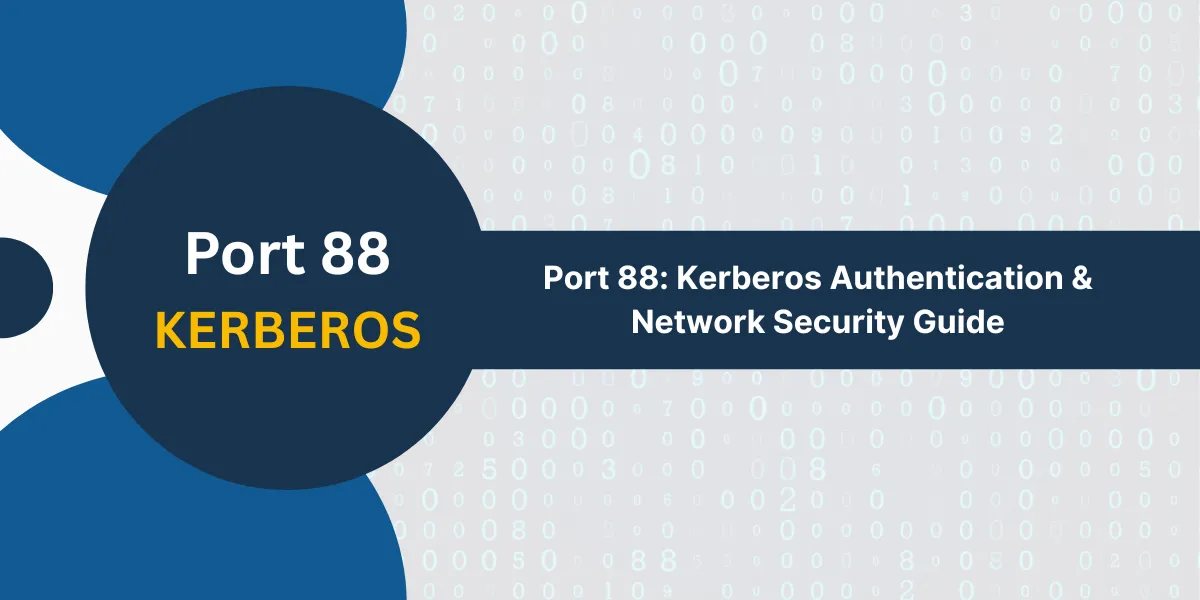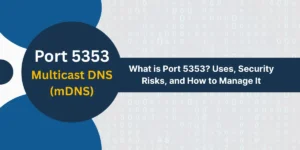Port 88 is the standard network port for Kerberos authentication services. This port enables secure user authentication in network environments using tickets and encryption. Kerberos uses Port 88 for both TCP and UDP protocols to verify user identities and grant access to network resources while protecting against unauthorized access.
What Is Port 88?
The network port 88 functions as the designated entry point for Kerberos authentication. The Kerberos authentication system depends on port 88 to enable secure connections between clients and servers which grant authorized users access to protected network resources. The Kerberos system operates through both TCP and UDP protocols where UDP serves standard ticket exchanges because of its speed but TCP handles larger ticket sizes.
The Application layer of the OSI model contains this port which serves as a fundamental component for Microsoft Active Directory (AD) networks and enterprise systems.
Understanding Kerberos Authentication Protocol
The Kerberos Authentication Protocol functions as a secure system which enables users to access multiple network resources through ticket-based authentication without needing separate login credentials for each request.
- The Key Distribution Center (KDC) serves as the access point for clients who want to request access through the client-server model.
- The authentication process generates a Ticket Granting Ticket (TGT) which enables clients to access resources without needing additional authentication steps.
- The system performs mutual authentication because both the client and server independently confirm each other’s identity to boost security measures.
How Port 88 Works with Kerberos Authentication
The operation of Port 88 within Kerberos functions as follows.
- The client initiates authentication requests to the KDC through Port 88.
- The KDC authenticates credentials before delivering a Ticket Granting Ticket (TGT) to the client.
- The client obtains service tickets (ST) for particular resources through the use of the TGT.
- The client gains network access through the system without needing to authenticate multiple times.
- The system implements ticket expiration and renewal functions which enable users to maintain continuous access.
- The authentication process decreases network traffic while providing users with improved convenience through minimized login requirements.
Why Port 88 Matters in Enterprise Networks
The significance of Port 88 in Enterprise Networks requires explanation.
- The protocol functions as a core component of Active Directory systems which Windows networks use for domain authentication purposes.
- The protocol enables single sign-on (SSO) functionality which simplifies user access operations.
- The protocol generates less network performance impact than other communication protocols do.
- The protocol provides secure authentication services that support large-scale user authentication for thousands of users.
Related Ports and Protocols
While Port 88 is dedicated to Kerberos, related ports play supporting roles:
Security Risks and Best Practices for Port 88
Despite strong encryption, Port 88 remains a target for attacks such as:
- Pass-the-Ticket (PTT) attacks, where stolen tickets are reused to impersonate users.
- Kerberoasting, an attack extracting service account tickets for offline password cracking.
- Unauthorized Key Distribution Center (KDC) access via exposed servers or weak passwords.
Best Practices to Secure Port 88:
- Use strong, complex passwords and enforce Multi-Factor Authentication (MFA).
- Restrict KDC and Port 88 access only to trusted IP ranges through firewalls.
- Enable encryption and network segmentation to isolate authentication traffic.
- Regularly patch and update Kerberos and domain controllers.
- Monitor Port 88 traffic with SIEM tools for abnormal patterns or brute force attacks.
- Employ Kerberos Armoring (FAST) and encryption extensions for enhanced protection.
Troubleshooting Port 88 Issues
The following problems occur frequently:
- The time synchronization process between clients and servers fails to work properly.
- Firewall systems prevent Port 88 traffic from passing through their systems.
- Misconfigured DNS.
- The system needs to switch to TCP when ticket sizes become too large.
Commands and Tools for Diagnosis:
# Verify Port 88 listening and connections netstat -an | find "88" # Test connectivity to domain controller on Port 88 telnet88 # Display current Kerberos tickets klist # Renew Kerberos tickets kinit
Port 88 Quick Facts
| Aspect | Details |
| Port Number | 88 |
| Protocols | TCP and UDP |
| Primary Use | Kerberos Authentication |
| Common Environment | Microsoft Active Directory |
| Security Risks | Pass-the-Ticket, Kerberoasting |
| Best Security Practice | Strong credentials, firewall rules |
| Troubleshooting Tools | netstat, klist, kinit, event logs |
Final Thoughts
The operation of secure Kerberos authentication depends on Port 88 which serves as the essential element for enterprise network authentication. The system provides secure single sign-on functionality when deployed correctly. Network administrators need to understand Port 88 operations and implement the best security practices to maintain network security in current times.
FAQs About Port 88
What is Port 88 used for?
Port 88 serves as the default port for Kerberos authentication protocol. The Kerberos protocol enables networked applications to perform secure authentication through verification of both clients and servers. The port functions as a ticket request handler and authentication service.
Is Port 88 TCP or UDP?
The Port 88 operates through both TCP and UDP network protocols. TCP ensures reliable data transmission for Kerberos authentication processes. UDP operates to process urgent ticket requests and manage small data packets.
Can I block Port 88?
Blocking Port 88 can disrupt Kerberos authentication services. Active Directory-based systems need Port 88 to perform authentication operations. Domain-joined computers need Network administrators to maintain access to Port 88.
Can I close Port 88 if Kerberos is not used?
Yes, but ensure no dependent services require it.
Is Port 88 a security risk?
The security risks of Port 88 remain minimal when the port functions with proper configuration. Kerberos authentication uses strong encryption methods. Regular security updates and monitoring systems prevent potential vulnerabilities from becoming actual security threats.
How does Port 88 relate to Active Directory?
The system provides secure authentication capabilities for AD domains.
How do I check if Port 88 is open?
The Port 88 status can be checked by users through the netstat and telnet command prompt tools. The network scanning tools show the status of Port 88 connectivity. System administrators need to check Port 88 status through their firewall configuration.

Priya Mervana
 Verified Web Security Experts
Verified Web Security Experts
Priya Mervana is working at SSLInsights.com as a web security expert with over 10 years of experience writing about encryption, SSL certificates, and online privacy. She aims to make complex security topics easily understandable for everyday internet users.



